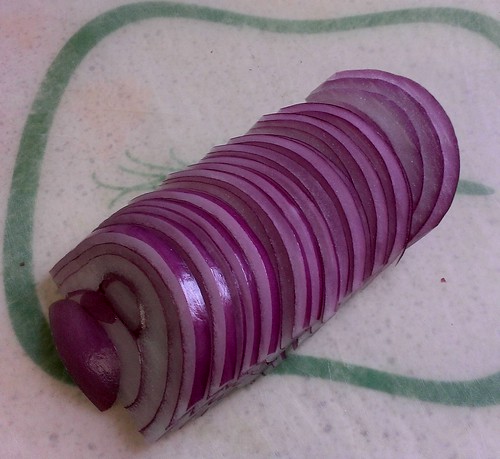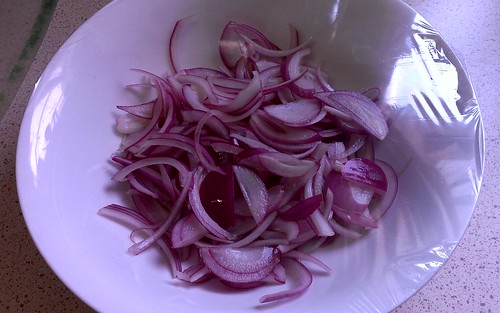Today I'm going to talk to you about the sour stuff. Sugar, spice and everything nice is all well and good, but we need the tart stuff, the zingy stuff, the stuff with bite. Take a mojito, for example. It's the lime which gives it that satisfying sourness, a good square kick in a sea of sugar. Sometimes, you need that in a drink. Or a salad. Or even a cake.
Food acids are our friends, because they provides a pleasing balance in each mouthful. Growing up in Malaysia, I recall rich, bombastically flavoured laksa always served with a side of green calamansi. You'd squeeze it onto that bowl of hot raging deliciousness, much like you'd squeeze lemon onto battered fish.
If a mouthful of food were a discoball (stay with me here) the various flavours of the food - salty, sweet, pungent, earthy, umami, etcetera, would be the little mirrored tiles. The sourness, the acidulant in that mouthful would be the flashing lights bringing all those flavours to life.
If a mouthful of food were a discoball (stay with me here) the various flavours of the food - salty, sweet, pungent, earthy, umami, etcetera, would be the little mirrored tiles. The sourness, the acidulant in that mouthful would be the flashing lights bringing all those flavours to life.
 |
| Red onion... only better. |
Okay, let's leave the 70's now and come back to the kitchen. Here, acidulants are most often liquids, such as juices (lemon, lime), vinegars (white, balsamic, rice, red wine) or extracts (verjuice, tamarind).
The more molecularly-minded among you may possess a jar of citric acid crystals in your gastro-kit, but personally my pantry ain't that fancy.
Chemically speaking, acidulants have a pH level of less than 7, adding a sour or tart note to a dish.
I won't go into the hard chemistry side of things because there are other much more well-informed people for that, not to mention I failed my Chemistry O Level spectacularly badly (my apologies, Mrs Thiagarajah!). Other forms of kitchen hoodoo using acidulants include making jams and jellies as well as pickling. Mmm... pickles. See below for some quick pickled onion magic.
On a more useful note, here's a few handy ways to use acidulants in the kitchen:
White vinegar for a happy meringue: Grab some kitchen paper, soak it in a little white vinegar and use it to wipe down the insides of the bowl you're going to whip your meringue in. This dissolves any surface oils because oil is deadly for meringues. You will not get soft peaks, hard peaks or any happy peaking if you have an oily bowl. Oil + egg whites = sadness. In fact, while you're at it, you should give the beaters a rinse in white vinegar too.
1-to-4 rule for salad dressings: One part vinegar/citrus juice to four parts oil, then season to taste - that's the basis for most well-balanced salad dressings. According to Stephanie Alexander in her
Say no to brown fruit: Squeeze lemon juice into a bowl, then use a basting brush to coat sliced apples, pears and bananas. If you find the lemony taste a bit strong use a more dilute solution of 1 part lemon juice to 4 parts water and dip the fruit pieces in.
Fruits turn brown when cut because of oxidization - that's when enzymes in fruit get exposed to air and the exposed surfaces begin to brown. It's definitely not harmful, but not exactly attractive. I wouldn't do this for every apple I eat, but if I was making a fancy fruit platter for someone I'd definitely grab that lemon.
Tame your onion:
I don't really want to call this a recipe, more of a suggestion. A way of making something nice even nicer. Basically, you just get a red onion, slice it finely, then toss it with a generous amount of red wine vinegar and a dash each of salt and sugar. Leave it for a few hours (4 minimum), overnight if you can. What happens is that the onion and the vinegar get to know each other a little better, resulting the onion turning from a purple-crimson shade to a soft ruby pink. It also goes a little limp, perfect for draping over salad leaves, fish, pulled pork or anything else which could use a hit of soft, sweet sharpness. You now have a very nice condiment. The raw onion is transformed from being an assertive take-charge fellow to one which now plays nicely with others and brings an apple to school for teacher.
 |
| 1) Grab your onion |
 |
| 2) Slice finely |
 |
| 3) Toss with a generous slug of red wine vinegar. Sprinkle sugar and salt. |
 |
| 4) Cover with clingwrap and leave overnight (or 4 hours minimum). |
 |
| 5) Ta-daa!!! Pink, soft deliciousness. Add it to stuff to make said stuff more tasty. Your work here is done. |

No comments:
Post a Comment